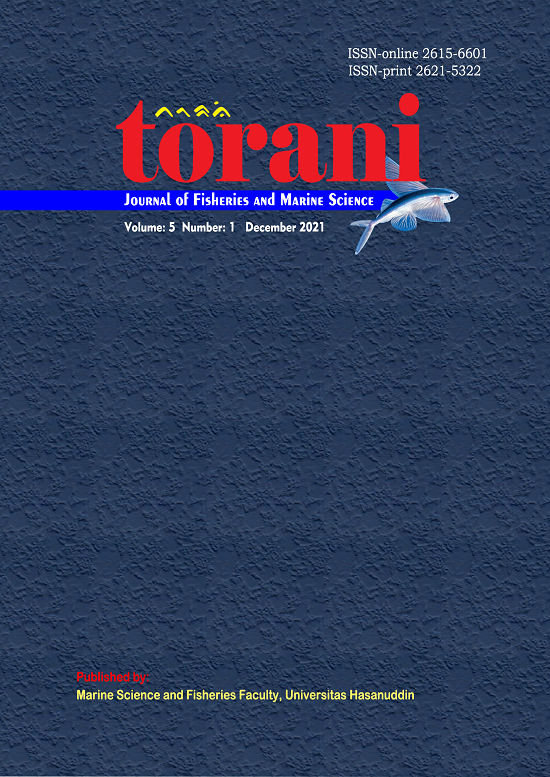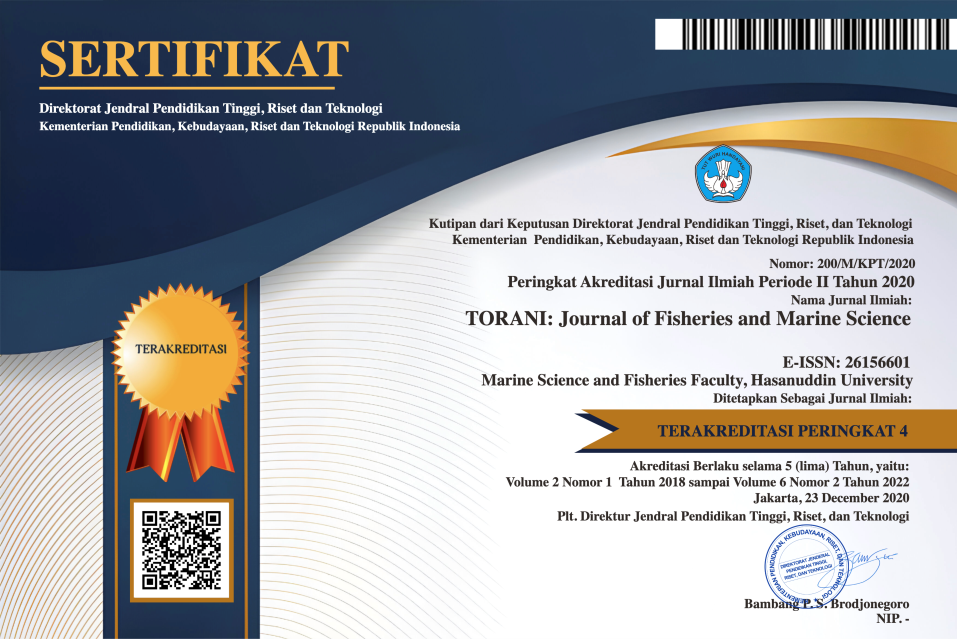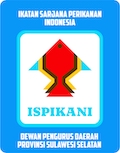Maritime Tourism Supports Improved Welfare of Coastal Communities in South Sulawesi
DOI:
https://doi.org/10.35911/torani.v5i1.19083Keywords:
Marine tourism, coastal communities, welfareAbstract
Indonesia has the potential for the beauty of its islands and coasts which are well known to foreign countries. Not only beautiful beaches, also stretches of coral reefs with hundreds of marine species, mangrove forests with their ecosystems are a panorama that can be found from Sabang to Maraoke. It is estimated that more than 21 marine tourism sites have been developed and become destinations for world and local tourists, in addition to locations that are still managed by the community. Foreign exchange contributions from the tourism sector continued to increase in 2018, the tourism sector's foreign exchange reached IDR 229.5 trillion, an increase of 15.4 percent on an annual basis. This study aims to describe the condition of marine tourism potential in South Sulawesi and its impact on local communities living around tourist sites and the development needed to improve the welfare of local communities. The research locations were on Lemo Beach, East Luwu Regency, Bira Bulukumba Beach and Makassar Lantebong Mangrove Tourism, taking 100 respondents. The research method is qualitative and analyzed descriptively by correlation and using Likers to assess its impact on people's welfare. The results of the study illustrate that in general, the role of the government, both local and provincial, is still needed, especially in environmental hygiene facilities, order for traders. The social impact on people's behavior shows that there is a change in the ability to communicate and interact more openly with a value of 1634. The economic impact shows a very large regional value due to the opening of new job opportunities which are a source of income for the local community with a value of 2250.
References
Annas, M., Nasrulloh, M. A., Rosid, M. H. Al, & Biati, L. 2017. Multiplier Efek Industri Kreatif Terhadap Kondisi Sosial dan Ekonomi Masyarakat Banyuwangi. Jurnal Hukum Islam, Ekonomi Dan Bisnis, 5(1), 88–104. https://ejournal.iaida.ac.id/index.php/istiqro/article/view/41/34
Astina, M. A., & Artani, K. T. B. 2017. Dampak Perkembangan Pariwisata Terhadap Kondisi Sosial dan Ekonomi Masyarakat Sanur. Jurnal Ilmiah Hospitality Manajemen, 7(2), 141–146. https://doi.org/10.22334/jihm.v7i2.9
Badan Pusat Statistik. 2020. Perkembangan Jumlah Kunjungan Wisatawan Mancanegara 2018-2020.
Badan Pusat Statistika. 2020. Grafis Perkembangan Jumlah Kunjungan Wisata Mancanegara Tahun 2018-2020.
Budiaji, W. 2013. Skala Pengukuran dan Jumlah Respon Skala Likert (The Measurement Scale and The Number of Responses in Likert Scale). Ilmu Pertanian Dan Perikanan, 2(2), 127–133.
Cahyaningrum, I. M. I. P. I. 2019. Cara Mudah Memahami Metodologi Penelitian. Deepublish. https://books.google.co.id/books?id=e--iDwAAQBAJ
Fyka, S., Yunus, L., Limi, M., Hamzah, A., & Darwan, D. 2018. Analisis Dampak Pengembangan Wisata Pulau Bokori Terhadap Kondisi Sosial Ekonomi Masyarakat Bajo (Studi Kasus di Desa Mekar Kecamatan Soropia). Habitat, 29(3), 106–112. https://doi.org/10.21776/ub.habitat.2018.029.3.13
Kardini, N. L., & Sudiartini, N. W. A. 2020. Faktor yang Mempengaruhi Daya Tarik Wisatawan dalam Pengembangan Pariwisata Bahari di Pantai Tanjung Benoa. Angewandte Chemie International Edition, 6(11), 951–952., 3(1), 106–125. https://doi.org/10.47532/jis.v3i1.7
Magfira, Z., Rihendra, R., & Polisda, Y. 2021. Pengembangan Objek Wisata Pantai Kito Kecamatan Linggo Sari Baganti Kabupaten Pesisir Selatan. Jurnal Kajian Pariwisata Dan Bisnis Perhotelan, 2(1), 53–58. https://doi.org/10.24036/jkpbp.v2i1.31472
Makkasau, N., Maru, R., & Nyompa, S. 2020. Peran Pemerintah dalam Pengembangan Objek Wisata Pulau Camba-Cambang Kabupaten Pangkep. UNM Geographic Journal, 3(2), 167–174. https://doi.org/10.26858/ugj.v3i2.22852
Mamengko, R. P., & Kuntari, E. D. 2020. Pengelolaan Pariwisata Bahari berbasis Community-Based Tourism dalam Peningkatan Ekonomi Masyarakat Pesisir. Media Wisata, 18(1), 1–20. https://doi.org/10.36276/mws.v18i1.72
Muawanah, U., Triyanti, R., & Soejarwo, P. A. 2020. Dampak Ekonomi Wisata Bahari Di Kabupaten Alor. Jurnal Sosial Ekonomi Kelautan Dan Perikanan, 15(1), 33–46. https://doi.org/10.15578/jsekp.v1i1.8841
Nengsih, N. S. 2020. Indikator Pembangunan Berkelanjutan di Daerah Pesisir dalam Keanekaragaman Hayati Laut untuk Mensejahterakan Masyarakat. Jurnal Ilmu Sosial Dan Ilmu Politik, 1(2), 151–162.
Republik indonesia. 2009. Undang-Undang Republik Indonesia Nomor 10.Tahun 2009 Tentang Kepariwisataan.
Republik Indonesia. 2014. Undang-Undang Republik Indonesia Tentan Pemerintahan Daerah.
Sihotang, S. P., Sulardiono, B., & Purwanti, F. 2017. Evaluasi Perkembangan Wisata Bahari di Pulau Tidung Besar Kepulauan Seribu. Journal of Maquares, 6(3), 302–310. https://doi.org/10.14710/marj.v6i3.20590
Sugiyono. (2010). Metode Penelitian Kuantitatif Kualitatif dan R & D. Alfabeta.
Wibowo, S., Rusmana, O., & Zuhelfa, Z. 2017. Pengembangan Ekonomi Melalui Sektor Pariwisata Tourism. Jurnal Kepariwisataan: Destinasi, Hospitalitas Dan Perjalanan, 1(2), 93–99. https://doi.org/10.34013/jk.v1i2.13
Yustinaningrum, D. 2017. Pengembangan Wisata Bahari Di Taman Wisata Perairan Pulau Pieh Dan Laut Sekitarnya. Program Pascasarjana, Universitas Brawijaya Malang, 11(1), 96–111. https://doi.org/10.31328/ja.v11i1.455















